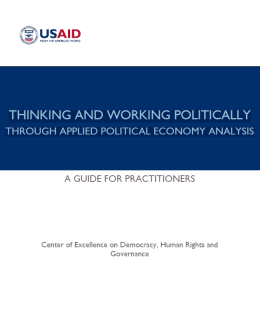This guidance provides information on how USAID can think and work in ways that are more politically aware — an approach known as “thinking and working politically” (TWP) 1 — through the use of applied political economy analysis. PEA is a structured approach to examining power dynamics and economic and social forces that influence development. Through programming that seeks to more rigorously respond and adapt to these realities, USAID is working to improve the effectiveness and sustainability of its international development efforts. PEA can help to operationalize the process of thinking politically, while USAID’s initiative on Collaborating, Learning and Adapting (CLA), described later in this guide, supports the operationalization of working politically. Together, they can add significant value to a mission’s strategy, projects and activities — offering the potential to address development challenges in all sectors. This guide follows the definition of politics as the process of determining “who gets what, when and how.”
USAID is working to build a culture where staff and partners continuously explore the context of a given system, to adapt programming according to realities on the ground and opportunities and barriers that emerge. This work is not simply about a particular analytical product; perhaps more importantly, it’s also about a mindset. This requires development practitioners to undertake a deliberate and continuous process of understanding domestic dynamics, and of inquiring how our interventions — or prospective interventions — may interact with and influence those dynamics. USAID’s Applied PEA Framework is thus intended to be used in an iterative and ongoing manner to deepen understanding of the context, and then reflect upon the implications of this understanding for adjusting and adapting programs as the context changes or new information becomes available. The framework outlines an analytical approach (or the “thinking” component in TWP) to help explore a question or puzzle that USAID staff would like to understand in greater depth. This involves reflection on: foundational influences (such as history or geography); the impact of immediate events and actors (such as leadership changes or natural disasters); and the institutional framework (encompassing formal laws and informal practices) that shapes the behaviors and outcomes observed. Considering all of these dynamics, incentives and interests, PEA investigates where locally driven opportunities for change may emerge and where constraints to such change may need to be addressed. For example, PEA may guide an exploration of the kinds of changes that may be possible when new leaders who espouse a commitment to combatting corruption gain power in a system that has historically been grounded in patronage. Finally, the PEA framework guides USAID staff to reflect on how insights emerging from the analysis might help inform operational practice. To clarify terminology used in this Guide, please see the Glossary of key PEA terms and concepts.
PEA can be initiated at any stage in the program cycle and is intended to guide adaptive management of smart, dynamic, locally owned and sustainable interventions. This guide describes how the use of applied political economy analysis can support more politically informed ways of thinking and working, with core resource documents and supplemental reference materials intended to support staff in operationalizing the process most effectively. This version of the guide updates the 2015 version.

